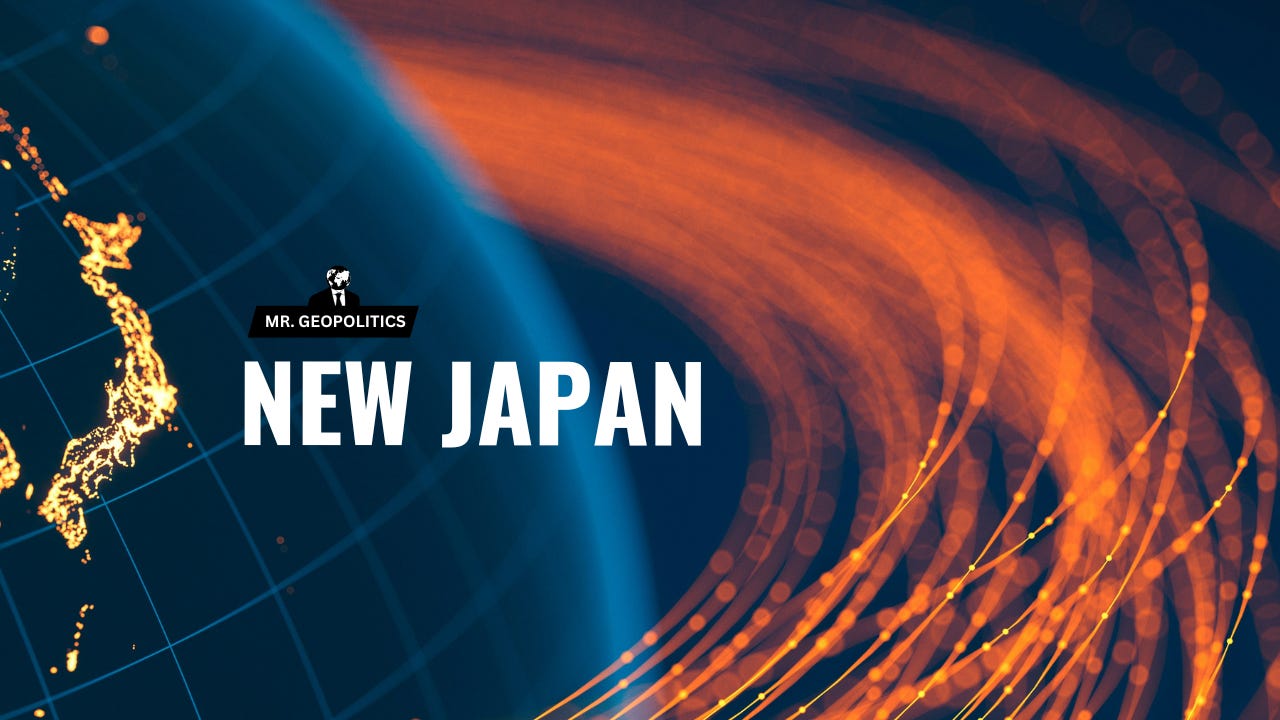Takaichi Eyes "New Japan"
Global fights give rise to a new outlook in Tokyo
Weeks ago, when Sanae Takaichi became Japan’s new prime minister and hosted US President Donald Trump, a major deal was signed that most of the world missed. It was not about rare earths but infrastructure. The Japanese committed $330 billion to upgrade the US energy grid, with particular focus on nuclear energy.
The agreement was not just about Tokyo keeping Trump happy (and ensuring the US-Japan trade and security relationship did not wobble). It was also about Japan’s new outlook. Takaichi was (and is) pushing the Japanese economy towards expansionism on the back of geopolitics. The rare earth deal further compounds this, as the US and Japan seek “coordinated investment” to break China’s hold over critical supply chains.
Japan’s trajectory is permanently changing, as friction in Asia, America First, rising geopolitical uncertainty, and a host of other factors converge, forcing Tokyo to move differently.
China vs. Japan
The latest flare-up between Japan and China is only a glimpse of what is to come between the two Asian rivals.
Weeks ago, Takaichi met with Lin Hsin-i, a senior advisor to Taiwanese President Lai Ching-te. This caused outcry in China. But it was not until the Japanese leader proposed that a Chinese attack on Taiwan could cause Japan to respond militarily that Tokyo-Beijing ties began to free-fall. As China warns its citizens against travel to Japan, causing almost 500,000 Japan-bound tickets from China to be cancelled, and forcing Chinese airlines to offer free refunds, the ground in Asia is shifting.
The conditions are forming for a new geoeconomic clash between Japan and China that could play out over years. The “short” stability between the two countries, like when China said it would restart seafood imports, is quickly disappearing. Japan is now eyeing a new foundation in Asia that blocks out China. Yet another critical economic relationship is entering dangerous waters, with stability and guarantees on the way out (like with US-China).
Under Takaichi, if China retaliates, Tokyo might not capitulate. As China hits tourism, Japan might strike technology. A freeze could blow over North Asia, reversing China-Japan relations, and cascading from South Korea to Australia to India.
A big part of this is the Japanese seeking a new kind of military readiness and reach that Asia has not seen in decades. This is not just about buying cruise missiles or upgrading warships. It is also about the deployment of Japanese forces and assets throughout the region. The signs are appearing that Tokyo may seek new bases and setups that take aim at the growing alignment between China, North Korea, and Russia.
Economic Security 2.0
Another sign of the Takaichi doctrine is the review of Japan’s economic security law. The bill passed in 2022 seeks to safeguard Japan’s technology and supply chains. Just three years later, however, Takaichi has directed the Japanese economic security minister, Onoda Kimi, to explore revisions.
What these revisions may be remains to be seen.
But it is likely to see Japan introducing more walls and restrictions regarding its strategic sectors, supply chains, foreign investment, and immigration. It may even build on the EU’s Anti-Coercion Instrument (ACI), which enables Brussels to bypass the legislature and take unilateral action against aggressors. Similarly, Tokyo may want more executive powers that enable rapid responses to geopolitical eruptions.
Public policy is not able to withstand the geopolitical pressures. Even policies designed for the global fights (like economic security legislation) are being explored as the climate worsens. The rules introduced 36 months ago no longer adequately defend economies.
New Isolation
Viewed from a higher plane, Japan is moving on two paths simultaneously: rebuilding and repositioning its military in Asia, and building a new economic shield against China. These are not short-term moves. This is a strategic recalibration by Takaichi that fundamentally changes Japan’s trajectory and future.
These are the messages after less than a month of Takaichi being the new Japanese leader. By the time spring approaches, Japan’s new outlook could be even more permanent and visible. However, hidden beneath all that Tokyo is doing is perhaps the most profound change: there is disappearing certainty as to how far the relationship with America can truly go.
The “new Japan” is not just about responding to adversaries, but also to allies. It is about revisiting the core ideas of how Japan functions regionally and globally, as a new environment forms that requires Tokyo to increasingly defend itself.
-ABISHUR PRAKASH AKA. MR. GEOPOLITICS
Mr. Geopolitics is the property of Abishur Prakash/The Geopolitical Business, Inc., and is protected under Canadian Copyright Law. This includes, but is not limited to: ideas, perspectives, expressions, concepts, etc. Any use of the insights, including sharing or interpretation, partly or wholly, requires explicit written permission.







